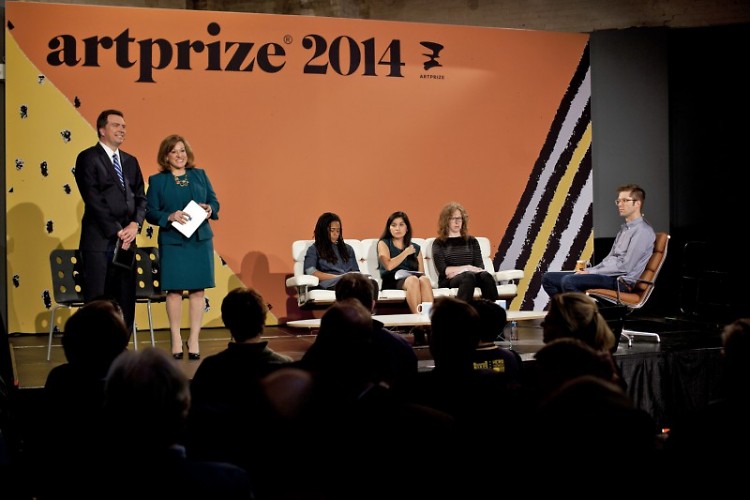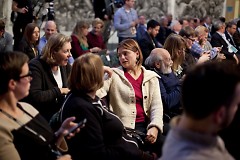Critical Discourse has, since year one of ArtPrize, been possibly my favorite night of the year- no exaggeration. I want real discussions about art. I champion the idea of building conversation. I miss “crit sessions” from art classes. I crave honest interactions where we can really analyze and discuss the qualities of artwork- or its lack.
This year, I got double the favorite nights: two nights instead of one, comparing jurors’ and public selections, in a new version called “Why These Finalists.” The first night’s discussion was followed up on Tuesday evening with a panel comprised of Nicole Caruth, Digital Content Editor for ART21, Mia Lopez, Curatorial Fellow at the Walker Art Center in Minneapolis and Paddy Johnson, founding editor of Art F City, more commonly known by their original name, Art Fag City, in New York.
But wait, before we throw down, there’s a rule. It’s a rule I required of my students, years ago, as I worked with kids who had little or no exposure to art museums and galleries before I got hold of them. It’s a rule I’m already discussing with my toddler. It’s a rule that I believe should apply to how we talk with the general population when we want them to start engaging more deeply with art as well.
The rule is simple: you can’t just say you like or don’t like something.
Our simply liking something is just our personal preference. It’s based in what we enjoy or don’t, what makes us happy or where our personal passions are. Personal preference says absolutely nothing about how successfully any created work is accomplishing its goal, and it says nothing about its historical and cultural context.
If we want our community and our culture to grow in their understanding of art, we’re going to have to get past “I don’t like it,” doing more than framing the conversation in mere likes and dislikes.
“I don’t think that there’s any sense in being mean for the sake of being mean,” explained Lopez at the end of day two of the “Why These Finalists” events. “Ideally, some of the comments that we made that might have been considered to be a little bit more harsh could be seen as constructive criticism and perhaps a point of departure for the artist to explore something new in their practice.”
That’s exactly what I was looking for.
On the first night of “Why These Finalists,” analysis too often devolved into likes and dislikes. Trying to cover too much in just one hour, the panel discussion was limited to rapid-fire opinions.
Paddy Johnson was asked at the end of the full two nights to explain what it’s like to give a really honest critique.
“It’s great,” she said to laughs from the audience. “I always feel like I’m getting something off my chest, like this was something I really wanted to say. I kind of love doing it.”
And here is where Johnson’s honesty could use some tweaking.
Being honest for the sheer sake of wanting to get something off your chest is not helpful for the community we’re trying to engage in caring about and understanding art. It is no help to artists who are working hard to communicate their visual or conceptual thoughts through their work. After all, artists want their work to, well, work. Distilling down to likes and dislikes doesn’t help artists know how to move forward and improve.
On the second night, opening remarks framed the discussion in that very distillation.
“Last night our panel of experts were brutally honest at times, and we expect that again tonight as they weigh in on what they like, and don’t like, at ArtPrize,” explained Brian Sterling of WOOD TV 8.
But instead, there was much more real discussion than the introduction led us to believe. ArtPrize seemed to have re-calibrated their pace, slowing down to have interaction between panelists. In that pace we found comment after comment that addressed what could have been improved- what stopped the viewer from engaging with the piece.
I challenge our community to do the same. As we head into our own art criticism and selection in these last two days of voting, and as we continue to discuss ArtPrize work and art throughout the year, let’s frame our conversations in ways that are helpful- to our community as well as to the artists. Let’s move beyond what we like to talking about the success of the work in front of us. There’s so much to discover when we can move past that first knee-jerk preference. Honest responses in art criticism are only helpful when their intent is just that: a desire to be helpful.
We all crave growth, honesty, improvement and understanding. And making a rule for ourselves to move beyond a simple “like” or a “don’t like” will inform our conversations and help get us to what we crave.
Sure, it’s scary. Yes, it requires more work. But we’ll all be better for it.
The Rapidian, a program of the 501(c)3 nonprofit Community Media Center, relies on the community’s support to help cover the cost of training reporters and publishing content.
We need your help.
If each of our readers and content creators who values this community platform help support its creation and maintenance, The Rapidian can continue to educate and facilitate a conversation around issues for years to come.
Please support The Rapidian and make a contribution today.

